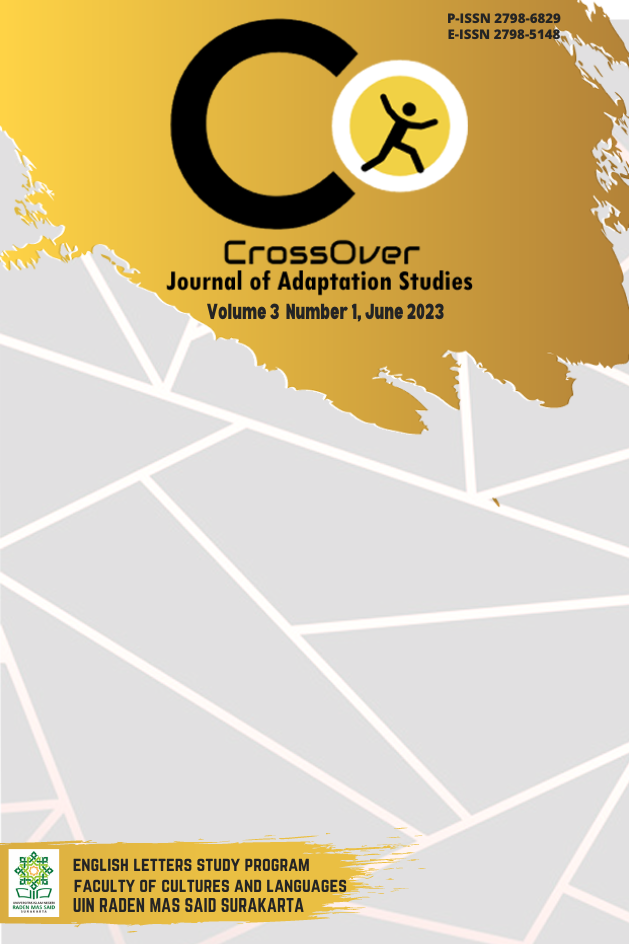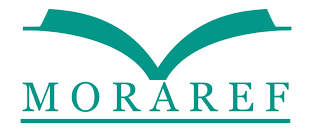ADAPTING MITCH ALBOM'S TUESDAYS WITH MORRIE TO FILM: CONVEYING LIFE VALUES
DOI:
https://doi.org/10.22515/crossover.v3i1.6978Keywords:
adaptation, content analysis, life value, Mitch Albom, Tuesdays with MorrieAbstract
Using an adaptation and content analysis approach, this study examined the transformation of Mitch Albom's novel "Tuesdays with Morrie" into a film. The primary concern was how this adaptation effectively conveyed the message of life values. The adaptation approach was employed to explore disparities in narrative, characters, and themes when a novel is adapted into a film. The content analysis approach was utilized to identify and analyze the portrayal of life values in both mediums. The data collection involved a comprehensive examination of the novel and a screening of the film adaptation. Relevant elements, including dialogues, narratives, characters, and themes pertaining to life values, were identified and documented. Subsequently, content analysis was conducted to identify patterns, themes, and messages concerning life values. The findings revealed that the film adaptation reflected the life values in the novel similarly, despite alterations and simplifications in the story and characters.
Downloads
References
Albom, M. (1997). Tuesdays with Morrie: An Old Man, a Young Man, and Life’s Greatest Lesson. Ballantine Books.
Ardianto, D. T. (2014). Dari novel ke film: Kajian Teori Adaptasi sebagai pendekatan dalam penciptaan film [From novel to film: Study of Adaptation Theory as an approach to film creation]. Panggung, 24(1), 16–24. https://doi.org/10.26742/panggung.v24i1.101
Baysal, A. (2018). An analysis of the film ‘Tuesdays with Morrie’ in terms of fundamental concepts of existential therapy. The Journal of International Social Research, 11(59), 621–626, http://dx.doi.org/10.17719/jisr.2018.2668
Dilley, W. C. (2014). The cinema of Ang Lee: The other side of the screen. University Press.
Hutcheon, L., & O’Flynn, S. (2013). A theory of adaptation (2nd ed.). Routledge.
Isnaniah, S. (2015). Ketika cinta bertasbih transformasi novel ke film [When love is glorifying the transformation of the novel to the film]. Jurnal Kawistara, 5(1), 23–35. https://doi.org/10.22146/kawistara.6401
Itafarida, S. (2007). Adaptasi dari karya sastra ke film: Persoalan dan tantangan [Adaptation from literary works to films: Problems and challenges]. Media Masyarakat, Kebudayaan Dan Politik, 20(2). http://journal.unair.ac.id/filerPDF/Adaptasi%20dari%20Karya%20Sastra%20ke%20Film.pdf
Jackson, M. (Director). (1999). Tuesdays with Morrie. Harpo Films.
Karlén, J. (2020). “Teaching the wrong things”? An Analysis of Ideology in Mitch Albom’s Tuesdays with Morrie [Bachelor’s thesis]. Mid Sweden University. https://www.diva-portal.org/smash/get/diva2:1532157/FULLTEXT01.pdf
Laugier, S. (2021). Film as moral education. Journal of Philosophy of Education, 55(1), 263–281. https://doi.org/10.1111/1467-9752.12551
Meyer, M. (2013). The Bedford Introduction to Literature: Reading, thinking, writing (10th ed.). Bedford/St. Martin’s.
Naremore, J. (1988). Acting in the cinema. University of California Press.
Nelmes, J. (2012). Introduction to film studies. Routledge
Nurafia, R., & Tjahjandari, L. (2022). Konstruksi spiritualitas tokoh utama dalam adaptasi novel ke film Rembulan di Wajahmu (2019). Deiksis: Jurnal Pendidikan Bahasa Dan Sastra Indonesia, 9(1), 83–91. https://doi.org/10.33603/deiksis.v9i1.6117
Perry, G. T., & Krippendorff, K. (2013). On the reliability of identifying design moves in protocol analysis. Design Studies, 34(5), 612–635. https://doi.org/10.1016/j.destud.2013.02.001
Pratama, B. I., Illahi, A. K., Pratama, M. R., Anggraini, C., & Ari, D. P. S. (2021). Metode analisis isi (Metode penelitian populer ilmu-ilmu sosial) [Content analysis method (Popular research methods social sciences)]. UNISMA PRESS.
Ratri, R. D. (2022). Ekranisasi novel terjemahan Kim Ji-Yeong born 1982 karya Cho Nam-Joo: Transformasi budaya misogini KE layar lebar dalam lingkup sasaran masyarakat misogini Korea Selatan [Ecranization of the translated novel Kim ji-yeong born 1982 by Cho Nam-Joo: Transformation of misogyny culture to the big screen within the scope of the target of South Korean misogyny society]. CrossOver: Journal of Adaptation Studies, 2(2), 19–34. https://doi.org/10.22515/crossover.v2i2.5399
Rohmah, Z. (2020). Morrie’s life, love, and death principles found in Mitch Albom’s ‘Tuesdays with Morrie’ [Master’s thesis]. UIN Sunan Ampel Surabaya. https://core.ac.uk/download/pdf/328932743.pdf
Stam, R. (2000). Film Theory: An introduction. Blackwell Publishers.
Tiani, K. D. (2014). Morrie Schwartz’s perspectives on American Values in Mitch Albom’s ‘Tuesdays with Morrie’ [Master’s thesis]. Universitas Brawijaya. https://www.neliti.com/publications/205186/morrie-schwartzs-perspectives-on-american-values-in-mitch-alboms-tuesdays-with-m
Tucker, N. (2022, August 22). 25 Years Later, “Tuesdays with Morrie” Still Resonates. https://blogs.loc.gov/loc/2022/08/25-years-later-tuesdays-with-morrie-still-resonates/
Winfrey, O. (2019). Tuesdays with Morrie (TV 1999). https://www.youtube.com/watch?v=E463tZdAGn4
Winter, R. O., & Birnberg, B. A. (2003). Tuesdays with Morrie versus Stephen Hawking: Livign or Dying with ALS. Literature and the Arts in Medical Education, 35(9), 629–631. https://fammedarchives.blob.core.windows.net/imagesandpdfs/fmhub/fm2003/October/Robin629.pdf
Wiranti, W. R. P. (2012). Prosedur Penerjemahan naturalisasi kata-kata budaya pada novel Tuesdays With Morrie karya Mitch Albom dan terjemahannya: Kajian penerjemahan dan kajian fonetis [Procedure for translation of naturalization of cultural words in the novel Tuesdays with Morrie by Mitch Albom and its translation: Study of Translation and Phonetic Study]. Students e-Journal, 1(1), 1–10. http://journal.unpad.ac.id/ejournal/article/download/1737/1753
Downloads
Published
How to Cite
Issue
Section
Citation Check
License
Copyright (c) 2023 syaifullah, David D Perrodin

This work is licensed under a Creative Commons Attribution-ShareAlike 4.0 International License.
Authors retain copyright and grant the journal right of first publication with the work simultaneously licensed under a Creative Commons Attribution 4.0 International License that allows others to share the work with an acknowledgment of the work's authorship and initial publication in this journal.

















